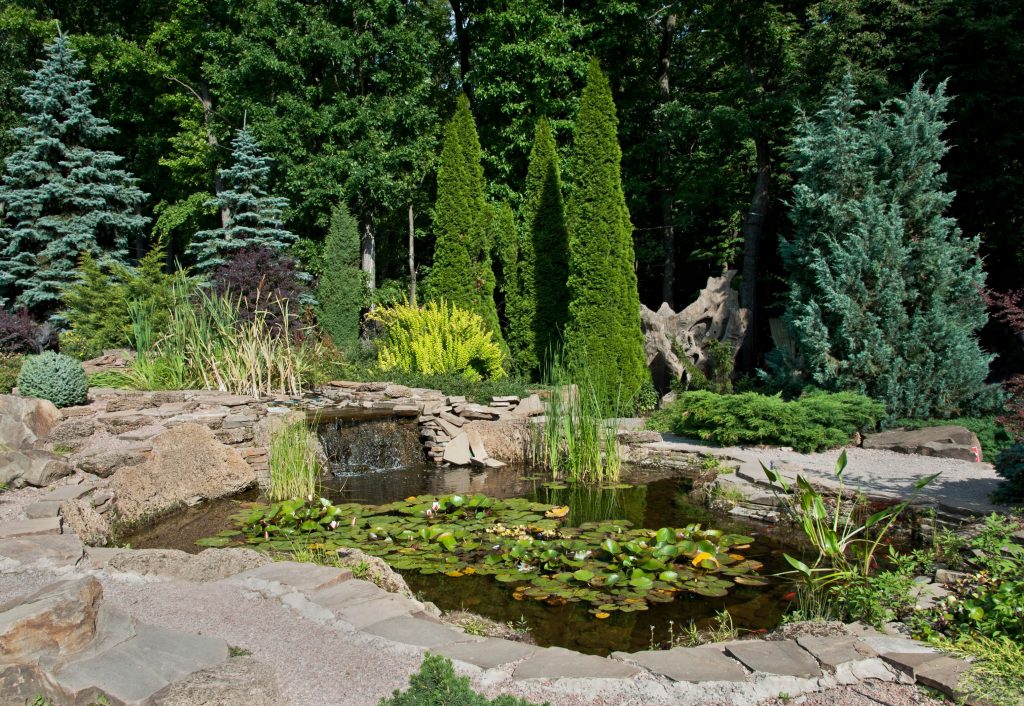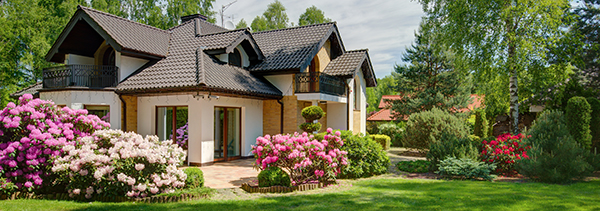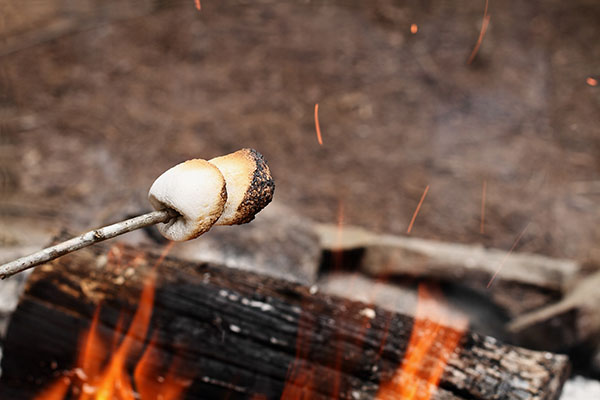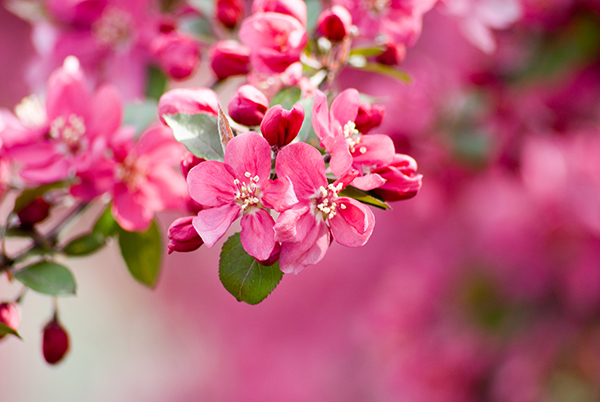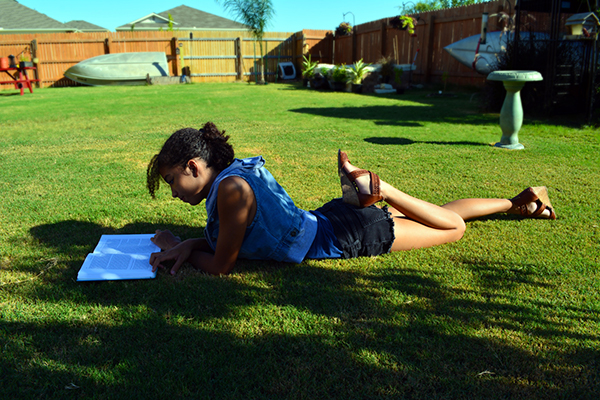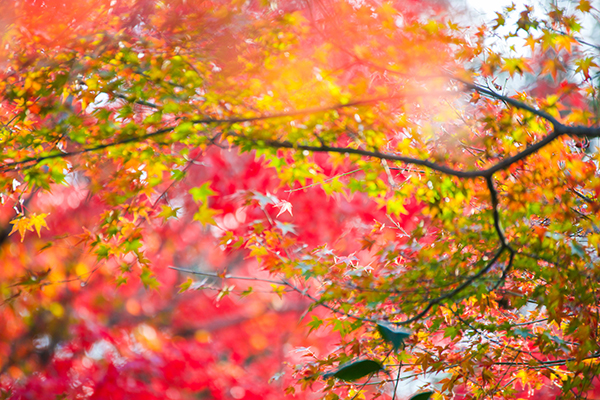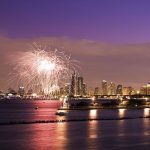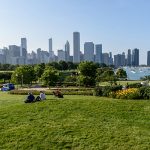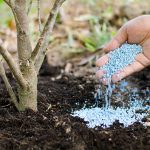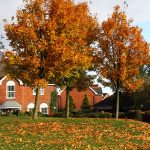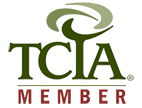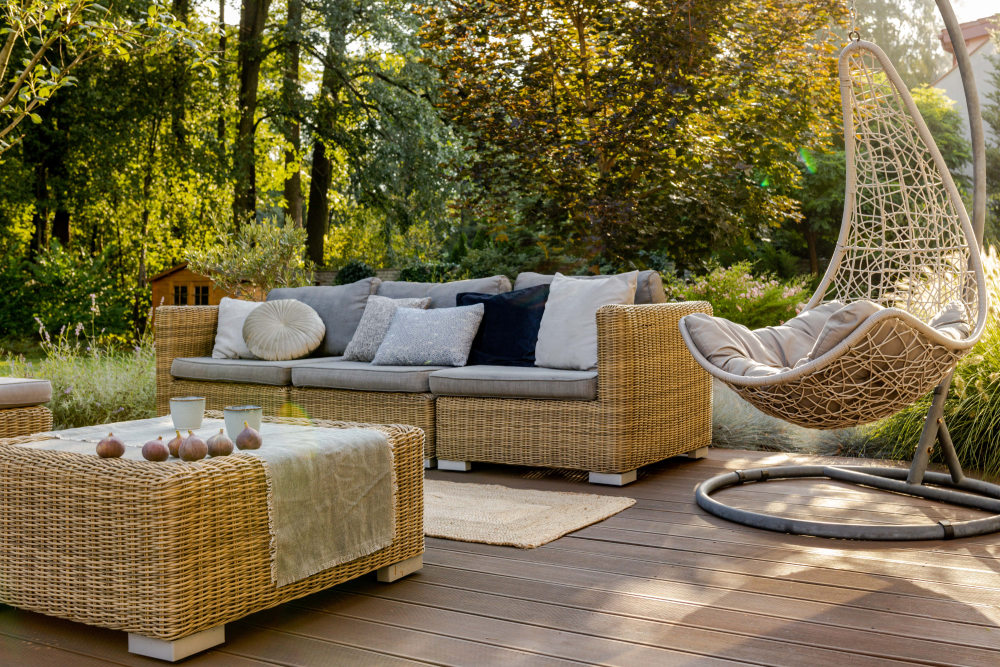
You may not get a palm tree in your Chicagoland backyard, but with some ideas from our blog you can build your very own backyard oasis this summer!
This summer in the Chicago area is going to be different than previous summers. Sure, Illinois is in Phase 4 of the re-opening plan, but the threat of COVID-19 is not gone. This will likely motivate people to continue to stay at home and ride out the pandemic safely. As you spend more time at home this summer, you can transform your yard into an oasis that makes your time at home more enjoyable. A great place to start is in your own backyard.
Your backyard is your slice of the outdoors that you can landscape and decorate anyway you want. You have the freedom to incorporate natural elements into your backyard landscape like trees, shrubs, and gardens, as well as other features like patios and decks, pools, and fire pits. You can even plant the trees and shrubs you want to plant based on the aesthetic of the foliage in a given season. Certain trees will yield beautiful flowers in the spring while other trees are better for fall foliage.
In this guide, we will cover some basic ways you can turn your backyard into an oasis with some simple additions and strategic backyard landscaping. Ensuring that the trees and shrubs in your backyard get adequate care will help preserve the beauty and shade that trees bring to your landscape. Hendricksen Tree Care provides full tree services that include tree treatments to protect against pests and diseases as well as tree trimming and tree planting. Our professional arborists will keep a record of the care we provide for your trees to ensure they always get the care and maintenance they need to grow to their full potential.
Pools and Ponds – A True Backyard Oasis
A pool is an excellent addition to your backyard that can make it an enjoyable oasis. However, pools also require maintenance and in the Chicago area, they can only be used several months out of the year. If you want to install a pool in your backyard, there are several things to consider:
- First, you need to decide whether you want an above-ground or in-ground pool. In-ground pools are much more expensive, and you will need professional help to dig up your backyard and install the pool. Above-ground pools are much less expensive, and some kits can be built and installed without the help of a professional.
- Choosing the location of the pool is the next step. The decision of where to put the pool will depend on where there is room and whether you want the pool in direct sunlight or the shade. Putting the pool in a non-shaded area will help keep the water at a good temperature and minimize the debris that gets in the pool. Putting the pool in a shaded area will help keep the water cooler, but you will have to regularly skim leaves and other debris out of the pool.
- Pools need regular maintenance throughout the time they are in use, including skimming, the addition of chemicals like chlorine, and repairs. Make sure you understand the commitment to pool maintenance in time, effort, and money.
A pool is not the only body of water that can turn your backyard into an oasis, you may also consider installing a pond. Ponds give the feel of a natural body of water in your backyard and they can be maintained to support animal life like fish. However, ponds need a lot of maintenance as it must be kept clean and oxygenated to support fish and other animals. This requires pumps and filters to keep the water clean and moving. When choosing where to put your pond, you also need to consider the location of trees in your yard as overhanging branches will cause more leaves and debris to end up in the pond. Ask one of our professional arborists the right way to incorporate trees with your pool to make a true oasis.
Patios and Decks – The Perfect Spot to Unwind in Your Backyard
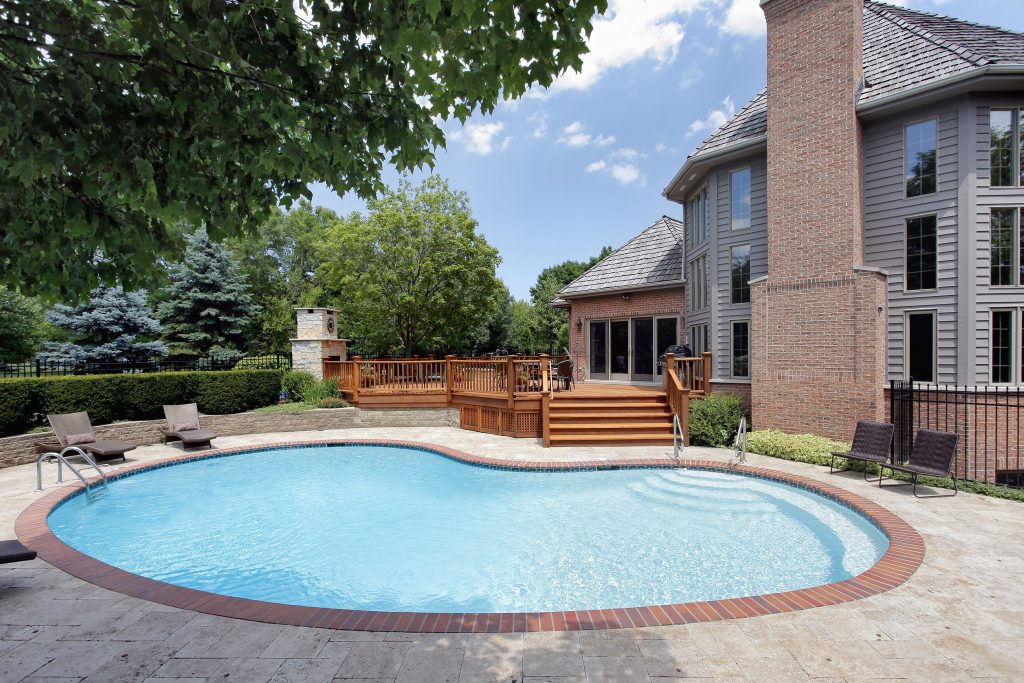
If your budget allows it, you can incorporate a pool with your deck or patio as well. Don’t forget to add a shade tree somewhere for a break from the sun
Adding a patio or deck to your backyard will give you a place to spend time outside and even entertain guests. The choice of whether to install a patio or deck will depend on your budget as well as the way your home is built. If the backdoor of your home is at ground level, a patio is a better option while a deck is the best option if the door is above ground level.
There is a lot that goes into building a deck. The design and materials of the deck will need to be carefully planned. In most cases, it is best to work with a professional to design and build a deck that works for your home. The possibilities are virtually endless as there are several types of wood and composite materials to choose from and it can be designed to be spread out or compact depending on the space in your backyard. You can also opt for a shady deck by building it near the shade trees in your yard or by planting trees around the edges of your deck. Keep in mind you will have to sweep up leaves and debris more often if tree branches hang over the deck, but the shade from the summer sun will be well worth it.
Patios are less expensive and easier to build because they are laid directly into the ground. You can choose from even more materials for patios as they can be built from wood, composite materials, stone, brick, or concrete. The size of the patio will depend on the available space in your yard and how you plan to use it. Once again, shade should be one of the things you consider, and you can expect to sweep the patio more often to remove leaves and twigs if it is in the shade. Our tree planting specialists can help you choose the right trees to compliment your deck or patio.
Flower & Vegetable Gardens – Beautiful & Practical
Gardens are a great natural addition to your backyard landscape and planting and maintaining a garden are great hobbies. You can plant a vegetable garden in your yard to grow your own vegetables or plant a flower garden to add a unique touch of natural beauty in your yard.
Before you start planting your garden, choose which type of garden you want. If you yard is big enough, you can plant a flower garden in one area and a vegetable garden in another. Once you decide on the type of garden, choose which flowers or vegetables you want to plant. Flowers can be chosen based on your preferred aesthetics and your vegetables should be chosen based on what you and your family will eat. Do not plant a vegetable that no one in your home will eat.
Once you have decided on the types of flowers and/or vegetables you would like to plant, you need to consider the soil conditions and sunlight needed for each plant. This will help you choose the best area in your yard to start your garden. Vegetables are more likely to need direct sunlight while it will depend with flowers.
Once you have decided where to plant your garden, you need to remove the grass and till the soil. For flower gardens, you may need to enrich the soil with the nutrients needed to grow your preferred flowers. For vegetable gardens, make sure you properly fertilize the soil as you plant your seeds.
Fruit Trees – Your Very Own Chicagoland Mini Orchard
If you would like to complement the vegetables from your garden with fresh fruit from your very own mini orchard, there are several types of fruit trees native to the Chicago area that can yield delicious fruit. Like with the plants in your vegetable garden, make sure you plant a fruit tree that produces fruit you and your family will eat.
You can plant the following types of fruit trees in your yard to produce edible fruit:
- Nectarine trees: Nectarine trees need plenty of space for the canopy to grow and they must be pruned yearly to promote fruiting. Nectarine trees that grow well in Illinois include Early Flame, Redchief, Sunglo, Redgold, and Cavalier.
- Peach trees: Like nectarine trees, peach trees need adequate space for their canopies to develop and must be pruned every year.
- Cherry trees: Sour cherry trees can grow well in the Chicago area. The best cherry trees to grow include Suda Hardy, Meteor, Mesabi, North Star, and Montmorency.
- Apple trees: There are a wide variety of apple trees that can be grown in Illinois and because they are cross-pollinating trees, it is recommended to grow two different varieties of apple trees on your property.
- Plum trees: European plum varieties such as Damson, Yellow Egg, Stanley, Dietz, Green Gage, and Bluefre can be grown in the Chicago area. These trees are cross-pollinating as well so you need to grow two trees of different varieties.
Fire Pits – Enjoy Your Yard Even at Night
A fire pit is a nice addition to a backyard as it is ideal for entertaining guests on a chilly night. There are many possibilities when it comes to building a fire pit as you must decide on the type of fire pit you want as well as the size and materials. You can build a fire pit in the ground in your backyard or build it into your patio. There are also portable, above ground fire pits that don’t need to have a permanent spot in your yard.
When installing a backyard fire pit, you need to consider the following:
- Decide on the type of fire pit you want and the size. Make sure it is at least 10 feet away from your home and other structures, bushes, and trees to prevent a fire. It is also best to put it somewhere where there are no tree branches above it. For more information, consult our guide concerning fire safety around your trees.
- Make sure the materials you use to build your fire pit are non-porous and not flammable. When building an in-ground fire pit, heat resistant materials like brick, stone, and concrete should be used for the outer walls. A steel ring or brick should be used for the inner barrier of the fire pit.
- Keep fire safety gear like a fire extinguisher handy. You never know what may happen and it is better to be prepared to prevent fires.
Seasonal Foliage – The 4 Seasons of Chicagoland
Trees and shrubs are a major feature of most landscapes that are built into backyards as they provide shade and natural beauty. There are many different trees native to the Chicago area that you can choose to plant in your yard. You can choose from flowering trees that bloom in the spring, trees that provide shade in the summer, trees that have impressive fall colors, and native pines and evergreens that will provide your backyard with color and privacy in the winter.
Spring Flowering Trees of Illinois
If you want your yard to have some extra color in the spring, there are many types of trees that flower early in the growing season. You can strategically plant the following spring flowering trees in your yard to enhance the beauty of your landscape in the spring season:
- White ash: White ash trees bloom heavily and have flowers that are yellowish green to greenish purple in color.
- Sassafras: Sassafras trees bloom flowers that are greenish yellow or yellow in color.
- Willow trees: Willows produce cylindrical shaped catkin flowers that are green in color in mid-spring.
- Ohio buckeye: These trees bloom yellow-green flowers that grow in clusters.
- American sweetgum: American sweetgum is a tall tree that produces greenish yellow flower clusters.
- Black locust: These trees produce small white flowers that have a yellow spot in the middle.
- Eastern redbud: Eastern redbuds are known for their purple and pink flowers that bloom before their leaves each spring.
- Yellow Poplar: These trees bloom cone-shaped flowers that are yellow-green in color.
- Dogwoods: Dogwoods are also known for their flowers that can be white, pink, or red in color.
- Crabapple: Crabapple trees bloom flower clusters that are purple, pink, or white in color.
- Carolina silverbell: These trees bloom white, bell-shaped flowers that dangle from the branches.
- Basswood trees: Basswoods bloom fragrant, drooping flower clusters that are cream colored.
Summer Shade Trees of Illinois
During the hot Chicago summers, it is nice to sit in a shaded spot in your yard. If you want shade in your backyard landscape over your pool, patio, or deck, there are several types of native Chicago trees that can provide excellent shade.
There are several benefits to having trees in your yard that provide shade. These trees will not only shade your yard but shade your home as well. This will reduce the amount of heat entering your home and cause your air conditioner to run less, resulting in lower energy bills. Trees that provide good shade will also provide wind resistance and prevent flooding in your yard from heavy rainfall.
The following are the best summer shade trees in the Chicago area:
- Red maple hybrid: The red maple hybrid can reach up to 60 feet in height and grow 40 feet wide, providing excellent shade. These trees are also more resistant to diseases than other maples.
- Sugar maple: Sugar maples can grow up to 75 feet tall and 50 feet wide and their lush foliage provides great shade.
- Red oak: Red oaks are fast growing oak trees that can reach 75 feet tall and they are resilient to Midwest weather conditions.
- Common hackberry: These trees can get up to 60 feet tall and 50 feet wide, providing a great deal of shade.
- Ginkgo: Ginkgo trees can grow up to 80 feet tall and their pyramidal canopy provides great shade.
- Kentucky coffeetree: These trees can get up to 75 feet in height and their leaflets provide excellent shade.
- American linden: The American linden can grow to be 80 feet tall and it has a dense canopy that provides good shade.
Trees for Fall Foliage in Illinois
When the fall season arrives, the trees around the Chicago area display a wide variety of vibrant fall colors. When choosing trees for your landscape, you may want to consider the autumn colors of each tree to have impressive fall foliage in your yard. There are so many trees that show great fall color; the following are just a few of the trees with impressive fall foliage in the Chicago area:
- Dogwood trees: Dogwood trees stand out stand out in fall landscapes because of their orange and vibrant red colors. As a bonus, these trees also have showy purple and pink flowers in the spring.
- Oak trees: Oak trees may show a range of fall colors from golden yellow to deep orange and red. These trees are also excellent shade trees in the summer.
- Ash trees: Ash trees can also show a wide range of fall colors from yellow and orange to red and even purple.
- Sassafras trees: The vibrant red and orange colors of the leaves make sassafras trees stand out in the fall.
- Sycamore trees: Sycamore trees have thick canopies that can turn shades of yellow, orange, and red all on the same tree.
- Hickory trees: The leaves of hickory trees turn shades of golden yellow and orange in the fall which contrast nicely against their dark colored bark.
- Maple trees: Maple trees may turn a variety of colors in the fall including yellow, orange, and red.
Winter Evergreens of Illinois
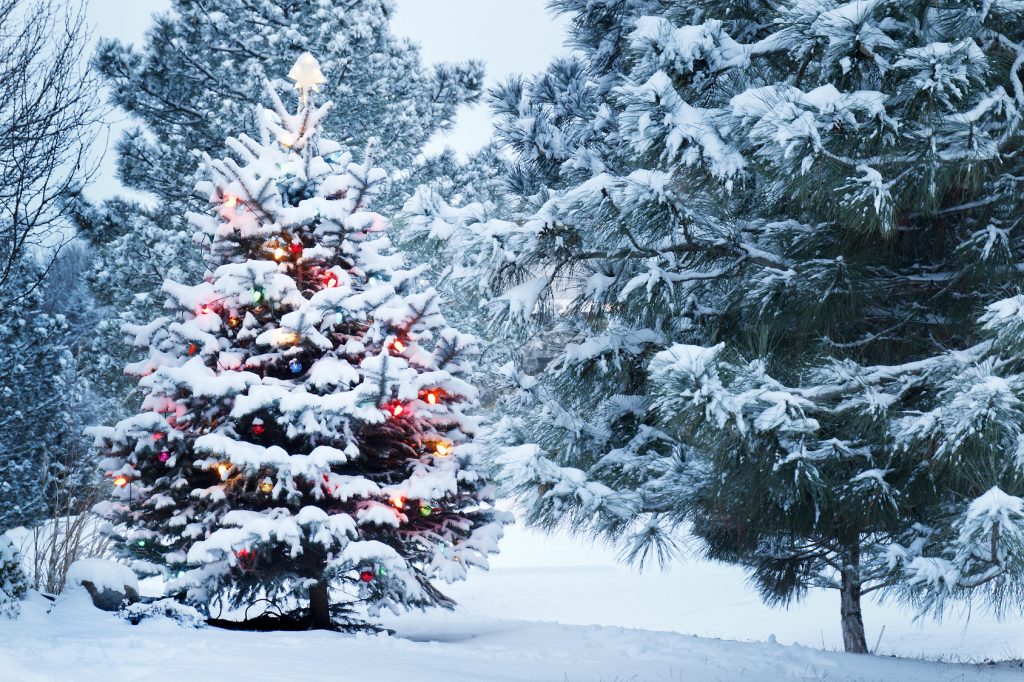
When planning your backyard oasis, consider all seasons. Trees such as Evergreens provide beauty and privacy all year round
Chicago winters often consist of harsh conditions as blizzards and subzero temperatures are always a possibility. While trees that are native to the Chicago area tend to be resistant against the winter weather, they spend the winters bare until their leaves grow back in the spring. However, there are a number of native pine trees that will stay green all year.
Planting evergreen trees like pine trees in your yard will help your landscape maintain some color in the winter and they will also provide you with privacy while the other trees are bare. The following are common pine trees native to the Chicago area:
- Eastern white pine: Eastern white pines have feathery needles that are almost blue in color. They get their name from their grayish bark.
- Red pine: These trees can get over 100 feet tall and they are named for their red, flaky bark.
- Shortleaf pine: These trees often have crooked branches and trunks and their pine needles are yellowish green in color and grow in bundles of 2 or 3.
- Virginia pine: Virginia pines are often sold as Christmas trees and they have short pine needles that grow in pairs.
- Pitch pine: These pine trees may have an irregular shape due to their twisted branches and curved trunks.
Tree Care and Planting Services from Hendricksen Tree Care
As the ongoing COVID-19 pandemic keeps you at home, take some time to turn your backyard into your own personal oasis. Additions like pools, fire pits, and patios can give you a place to relax outside while planting a garden and additional trees can help bring natural beauty to your landscape. When it comes to planting trees, this cannot be done haphazardly. Make sure you plant your trees correctly depending on the type of tree and the amount of sunlight and space they need. A professional arborist like Hendricksen Tree Care and also help you plant your trees and provide effective care.
At Hendricksen Tree Care, we provide complete tree care services that include fertilization, tree trimming, and treatments to treat and prevent diseases and pest infestations. Our arborists will get to know your trees and ensure that they get the comprehensive care they need to provide natural beauty to your backyard oasis.
We provide complete tree care services in Arlington Heights, Highland Park, Northbrook, Mount Prospect, Palatine, Lake Zurich, Park Ridge, Vernon Hills, Glenview, and the surrounding north and northwest Chicago suburbs.
